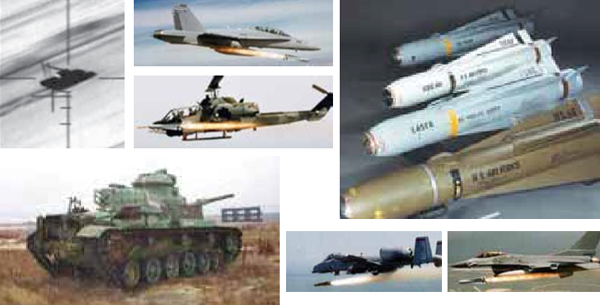
TODAY’S MAVERICKTM provides aircrews with launch-and-leave capability across a wide span of employment ranges and speeds. With its one-meter precision accuracy and lethal warhead, Maverick gives a high singlepass probability of success, with low collateral damage — attributes of the modern battlefield. Its modular design provides nine configurations with choices of three different seeker/guidance options, two different warheads and fuzing options, plus a rocket motor safe-arm option for naval flight deck operations.
Maverick is certified on more than 25 types of aircraft and is effective against nearly all air- to-ground target sets in battlefield, urban and maritime, including field fortifications, bunkers, tanks, armored personnel carriers, parked or taxiing aircraft, radar or missile sites, port facilities, ships, high-speed vehicles, swarming boats and other time sensitive threats. Maverick continues to evolve, providing cost effective solutions to meet current and future capability needs for network centric warfare.
TV MAVERICK The first Maverick produced was the television (TV) guided AGM-65A, delivered in 1972, followed in 1975 by the AGM-65B, with scene magnification optics. AGM-65A and B versions are now being upgraded to the newer H, J, JX and K configurations for U.S. and international customers. The newer configurations incorporate modern chargecoupled-device (CCD) TV technology, circuitry and associated software to more than triple the lock-on and launch range of the original versions. The CCD seeker’s sharper image gives the aircrew longer acquisition and launch ranges, allowing greater use of the aerodynamic envelope of the missile. The tracking software and cockpit display symbology are the same as those used successfully in infrared (IR) guided missiles. The superior service life of Maverick’s center-aft section makes upgrading AGM-65B to AGM- 65H missiles a viable and highly affordable option. Infrared Maverick The U.S. Air Force’s AGM-65D, G and G2 and the Navy’s AGM-65F are equipped with IR seekers that work in both day and night situations. The IR seeker presents a TV-like image on the cockpit display as it senses small differences in heat energy between target objects and the surrounding background. The tracking software for the IR missile has evolved to effectively accommodate a wide spectrum of land and maritime targets.
THE FUTURE OF LASER MAVERICK
Raytheon is designing a new laser guidance and control section (GCS) to allow production of Laser Maverick (AGM-65E2) missiles. This next-generation Laser Maverick uses digital Semi-Active Laser (dSAL™) seeker technology that allows tighter tracking against high-speed moving targets and greater precision in tough urban environments, while minimizing collateral damage. The new Laser Maverick GCS uses key components from existing Mavericks, to include: circuit card assemblies, autopilot, and electrical interfaces. The new GCS can mate to existing Maverick center-aft sections and retains Maverick shape and mass properties to reduce cost and schedule time. The missile uses built- in-test to limit test equipment requirements. Laser Maverick requires no aircraft operational flight program changes and no change in launch aircraft. Incorporating GPS/INS features is under consideration to improve end-game accuracy, permit adverse weather employment, and offer an expanded engagement envelope.


